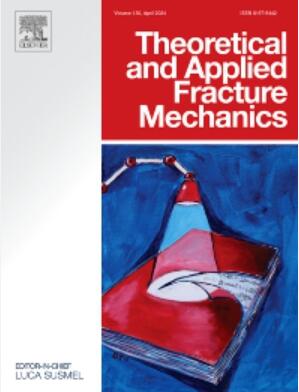基于3D-ILC的脆性固体内部裂纹单轴拉伸扩展及断裂机制
IF 5.6
2区 工程技术
Q1 ENGINEERING, MECHANICAL
引用次数: 0
摘要
由于岩石的抗拉强度较低,在拉伸荷载作用下,内部裂缝的扩展极易导致岩石工程无预警破坏。为了揭示三维内部裂纹在拉伸载荷作用下的扩展和断裂机理,进行了单轴拉伸试验。本研究采用3D- ilc (3D-internal laser- carving crack)方法对透明类岩石材料内部预制的3D内裂纹进行了数值模拟。结果表明:在轴向拉伸作用下,裂纹扩展面沿试件外表面自内向外呈“S”形扩展,在主最大拉应力处靠近裂纹面左右边界处近似水平;根据断裂面沃尔纳线的分布和方向可知,预制裂纹在单轴拉伸作用下先在圆环内扩展,然后转变为波形向两侧横向边界传播;不同倾角下单轴拉伸下裂纹扩展趋势基本一致,能量释放率理论公式与数值模拟结果相互验证揭示了KII/KI与裂纹偏转角的关系,即裂纹预倾角增大,KII/KI随之增大,裂纹偏转角也随之增大。研究结果将为研究包括岩石在内的各种脆性材料在拉伸加载条件下的内部裂纹扩展和断裂机制提供实验和数值参考。本文章由计算机程序翻译,如有差异,请以英文原文为准。
Propagation and fracture mechanism of an internal crack in brittle solid based on 3D-ILC under uniaxial tension
Owing to the low tensile strength of rocks, internal crack expansion under tensile loading is highly susceptible to causing rock engineering failure without warning. In order to reveal the propagation and fracture mechanism of 3D internal cracks under tensile loading, uniaxial tensile tests. numerical simulations were carried out in this study using the 3D-ILC (3D-internal laser-engraved crack) method for prefabricated 3D internal cracks inside transparent rock-like materials. The results indicate that: under axial tension, the crack propagation surface is “S” shaped from the inside to the outside through the outer surface of the specimen, near the left and right side boundaries of the crack surface in the principal max tensile stress is approximately horizontal; According to the distribution and direction of the Wallner lines of the fracture surface, it is known that the prefabricated crack firstly propagates in the ring under the action of uniaxial tension and then changes into a wave shape to propagate to the transverse boundaries on both sides; The trend of crack propagation under uniaxial tension at different inclination angles was basically the same, and the relationship between KII/KI and crack deflection angle is revealed by mutual verification of the theoretical formula of energy release rate and numerical simulation results, i.e., the pre-crack inclination angle increases, KII/KI increases subsequently, and the crack deflection angle also increases. The research findings will serve as experimental and numerical references for studies on the propagation and fracture mechanism of internal cracks under tensile loading conditions across a spectrum of brittle materials, including rocks.
求助全文
通过发布文献求助,成功后即可免费获取论文全文。
去求助
来源期刊

Theoretical and Applied Fracture Mechanics
工程技术-工程:机械
CiteScore
8.40
自引率
18.90%
发文量
435
审稿时长
37 days
期刊介绍:
Theoretical and Applied Fracture Mechanics'' aims & scopes have been re-designed to cover both the theoretical, applied, and numerical aspects associated with those cracking related phenomena taking place, at a micro-, meso-, and macroscopic level, in materials/components/structures of any kind.
The journal aims to cover the cracking/mechanical behaviour of materials/components/structures in those situations involving both time-independent and time-dependent system of external forces/moments (such as, for instance, quasi-static, impulsive, impact, blasting, creep, contact, and fatigue loading). Since, under the above circumstances, the mechanical behaviour of cracked materials/components/structures is also affected by the environmental conditions, the journal would consider also those theoretical/experimental research works investigating the effect of external variables such as, for instance, the effect of corrosive environments as well as of high/low-temperature.
 求助内容:
求助内容: 应助结果提醒方式:
应助结果提醒方式:


